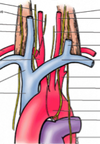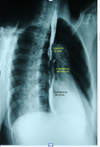Mediastinum 2 Flashcards
Where does the vagus nerve (R/L) enters the superior mediastinum?

They enter posterior to the respective sternoclavicular joint and branchiocephalic vein.
Where does the right vagus nerve enters the thorax, and what does it give rise to?
It enters anterior to the right subclavian artery and it gives rise to the right recurrent laryngeal nerve.
The right recurrent laryngeal nerve innervates the _______
Larynx.
True or False:
The right vagus nerve passes anteriorly to the right brachiocephalic vein, superior vena cava, and root of the right lung.
False, it passes posteriorly.
Going from superior to inferior, the right vagun nerve is part of what plexuses?
First right pulmonary plexus and then esophageal plexus and cardiac plexus.
Where does the left vagus nerve enters the mediastinum?
It enters between the left common carotid artery and left subclavian artery.
What nerves does the left vagus nerve give rise to and where?
The left vagus nerves gives rise to the left recurrent laryngeal nerve when it curves medially at the inferior border of the aorta.

What does the phrenic nerve innervates and where does it enters through?

- Innervation:
- Diaphragm with motor and sensory fibers
- Pericardium and mediastinal pleura with sensory fibers.
- Enters between the subclavian artery and the origin of the branchiocephalic vein
What helps you distinguish the phrenic nerve from the vagus nerve?
The phrenic nerve pass anteriorly to the roots of the lungs while the vagus nerve pass posteriorly to the roots of the lungs.
True or False:
The right phrenic nerve passes along the right side of the right brachiocephalic vein, superior vena cava, and pericardium over the right atrium.
True
True or False:
Most branching of the phrenic nerves for distribution to the diaphragm occurs on the diaphragm’s inferior (abdominal) surface.
True
True or False:
Left phrenic nerve crosses the left surface of the arch of the aorta posterior to the left vagus nerve.
False, it passes anterior to the left vagus nerve
What does the recurrent laryngeal nerves innervate?
They innervate all intrinsic muscles of the larynx, except cricothyroid
If you have an injury to the recurrent laryngeal nerves, what is affacted?
- voice
- It may be involved in bronchiogenic or esophageal carcinoma
- enlargement of mediastinal lymph nodes
- aneurysm of the arch of the aorta.
At what level does the trachea ends?
It ends at the level of the sternal angle by diving into right and left bronchi and superior to the level of the heart.








